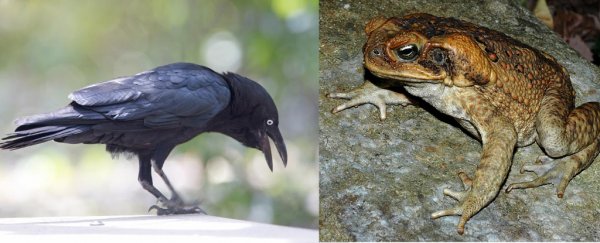Give a corvid a conundrum and it won't stay stymied long - the long-beaked birds have legendary problem-solving skills. In fact, they're so clever that Australian crows have even figured out a way to eat poisonous cane toads.
The cane toad, Rhinella marina, a species native to south and central America, was brought to Australia in 1935 in an attempt to control native beetles destroying sugar cane crops. Things didn't work out well.
There was a lot cane toads could eat, and not much that could eat them - in part thanks to the toads' poison glands - so the population boomed, and has since spread across most of the continent's north-east.
And to make it even worse, native animal populations drop wherever the cane toad spreads - due to competition for resources and also the fact that most predators who eat them get poisoned.
When threatened, cane toads ooze white poison called bufotoxin from parotid glands on their backs. According to the Global Invasive Species Database, it's been known to kill cats, dogs, snakes, lizards and even humans.
There are programs to try and train animals away from eating cane toads, but Australian crows (Corvus orru) don't need any of that.
These birds have figured out how to get a meal and how not to get poisoned - and now an Australian nature photographer has captured a crow in action:
Nature photographer Steve Wilson captured this rare scene of a torresian crow meticulously making a meal of a cane toad: https://t.co/YHyeny74Ed pic.twitter.com/FG6bakH84S
— Australian Geographic (@ausgeo) January 28, 2018
"Crows avoid contact with the ooze by grasping them by the limbs or even the bony brow above the eye, avoiding the body itself," nature photographer Steve Wilson writes for Australian Geographic.
"These clever birds have learnt to roll the toads onto their backs, sometimes doing so repeatedly if the luckless toad tries to hop away. Crows know which bits to eat - fleshy thighs, tongues, intestines - and how to get at these from below without contacting the lethal parts."
It's probably more a testament to the crows' cleverness than a solution to the cane toad conundrum.
The bird Wilson observed took 40 minutes to eat its fill, and there were an estimated 200 million cane toads hopping around Australia as of 2006 - and they're still spreading.
If climate change continues, wildlife authorities believe the toads could spread as far south as Sydney, and all the way across to Western Australia.
And, according to the Australian Government's Department of the Environment and Energy, "There is unlikely to ever be a broadscale method available to control cane toads across Australia."
Let's not even get started on rabbits. Or foxes, or cats. It's just too depressing.
But if you want to read more about how awesome crows (and ravens) are, we've totally got you covered.
